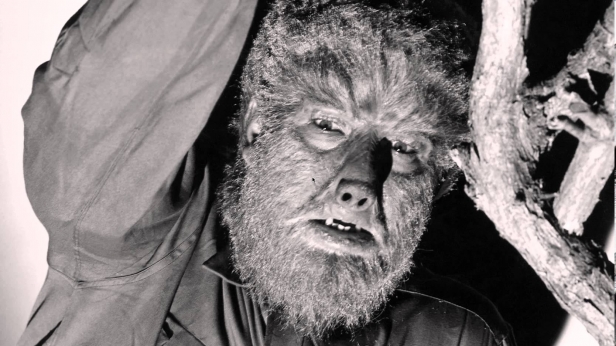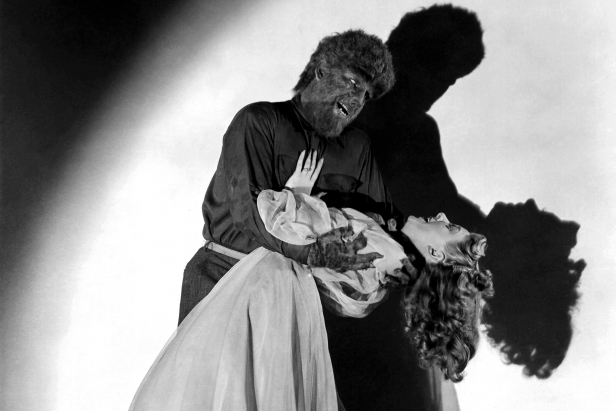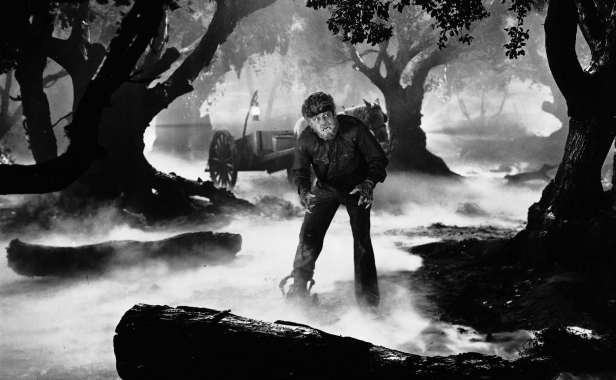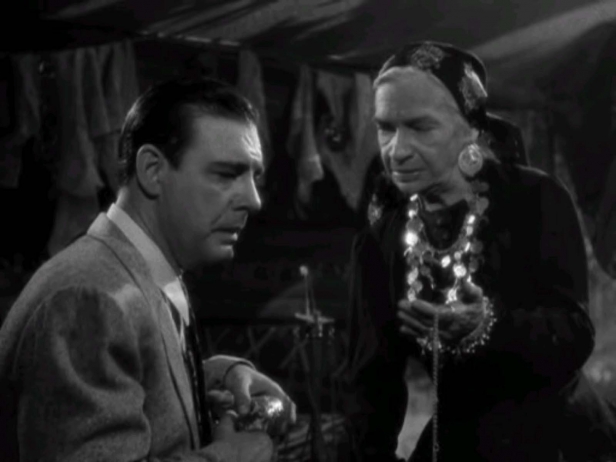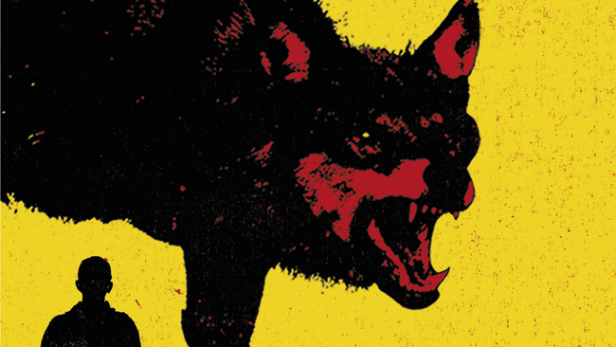On The Wolf Man Turning 75
In 1941, screenwriter Curt Siodmak reimagined the werewolf for the twentieth century. Before his and director George Waggner’s The Wolf Man, the werewolf had been an ungainly conglomeration of legend and lore—a campfire monster, more or less, with each new telling adding another spur-of-the-moment characteristic.
A werewolf’s the one with the eyebrows that touch in the middle, right? Or is it hairy palms? Or is that long middle finger? And, do they kill their beloved at the full moon, or do they plunder fresh graves? Two feet or four? Canine snout or just bushy sideburns? Do werewolves maintain their human intelligence, or does the wolf form give license to man’s more bestial nature? Is being a werewolf a condition of the mind or an inherited trait? Does it come from a spell, a salve, a belt, a skin, a bite? Are all seventh sons really werewolves, or is it all children born to priests? Or is it all children born on Christmas? Are werewolves really in the employ of the devil, or are they werewolves because they made a deal with the devil? Is a witch in wolf-form a werewolf? Is the werewolf to be pitied, to be feared? All of the above, some of the above? More?
It was getting to be too much baggage for even the werewolf to carry.
Just eight years before The Wolf Man, another screenwriter, Guy Endore, had tried to compact the werewolf down into a single form with his novel The Werewolf of Paris. And it was a valiant effort, to be sure. To try to fit everything in, Endore had to track a more than slightly-cursed character from birth to adulthood, and finally to the asylum and death, as polite society—Warren Zevon notwithstanding—doesn’t allow werewolves.
The result of Endore trying to fit everything in, it’s an entertaining story, to be sure, but the monster in the spotlight, it finally doesn’t make sense, is always shifting from actual to virtual, from physical to mental.
And, while the werewolf in the 1935 film Werewolf of London wasn’t nearly so chimeric, still, rather than trying to engage all the centuries of myths and legends surrounding the werewolf, Werewolf of London instead more or less offers a wolfed-out version of Stephenson’s The Strange Case of Dr Jekyll and Mr Hyde, which had just been famously adapted for the screen in 1931.
We can try to look back to the nineteenth century for precedent and lines of influence, of course, to George Reynolds’s Wagner the Wehr-wolf and Alexandre Dumas’s The Wolf-leader, but the Wagner is pretty much a soap opera character, and the wolf-leader’s werewolfism is the direct result of a deal with the devil, and never actually requires a transformation .
Curt Siodmak was taking the werewolf a completely different direction. It’s as if he took a sounding of all these texts, and then decided that, instead of building upon them, he would, instead, just start all over.
But no, as if often claimed, he didn’t come up with The Wolf Man’s wolf man completely from scratch. Let’s tick through the characteristics right quick, and trace their origins out:
- The two-legged, ‘upright’ wolf—the man-wolf. This had already happened in Werewolf of London, but it was old even then. Really, check out that famous image of Lycaon, running from the table after Zeus has cursed him into a wolf. Note how Lycaon still has most of a human body, but already has a wolf head. Granted, thuogh, he’s mid-transformation. Search “Werewolf of Athens” up, then. It’s pretty much Lon Chaney, Jr. in full make-up, just, on the side of an amphora. And stories of werewolves lumbering around on two feet are all up through the centuries. Dumas even uses it to creepy good effect in The Wolf-leader (just, not for the actual “werewolf”).
- The moon as trigger. First, in The Wolf Man, the moon actually isn’t the trigger. Listen to the rhyme. It’s “when the wolfsbane blooms” that the man transforms. And, note that Bela’s forced transformation, it’s not due to the moonlight striking him, it’s the wolfsbane laid on the table before him, the wolfsbane that’s evidently in bloom right now, and so will come to transform Lawrence Talbot as well. As for where this moonlight-association actually got started, it’s Petronius’s Satyricon. And it’s just that: an association. Not a trigger. As for the association, it’s probably simply because you see more animals under a full moon than a new moon, since there’s more light to actually see by. The easy assumption then, it’s to make some causal connection—as Werewolf of London does, in 1935. Which is the earliest moon-compelled transformation I know, even though Wagner, being a serial, was built for compulsory cyclic transformations.
- Bite-to-infect. Of course this comes from seeing rabies spread and not having a real understanding of virus-transmission—it would seem it’s the madness that’s infectious, that animal B is becoming what animal A, doing the biting, is—but it’s got some folkloric origin to it as well. 1651, a kid named Hans is brought to trial for being a werewolf, which he readily admits to, much as Peter Stubbe and Jean Grenier had fifty years before. However, unlike anybody who’s confessed before him, he claims to have become a werewolf due to encountering a man in the woods, who, instead of making a deal with him as is usually the case, bites Moreover, Hans claims that this man was himself a werewolf, not the devil, as has always been the case. However, until 1941, this—what we now consider a trope of the werewolf genre—wouldn’t be used again. So, yes, assuming Hans the Werewolf wasn’t in circulation for Curt Siodmak, it’s perfectly possible he invented it. A more likely possibility? He ported it across from the vampire. Why invent something when it’s right there for the taking.
- Silver. In Werewolf of London, it just takes regular bullets to dispatch the werewolf. Why not silver? Probably because Abel Chevalley’s La Bête du Gévaudan wasn’t published until 1936. That’s when silver was introduced as the thing that brings down the famous Beast of Gevaudan—a purported werewolf, ravaging the eighteenth century French countryside to tune of a hundred and more people. However, long before that the Grimm Brothers had recorded stories of hunters loading their guns with silver buttons to bring down witches in animal form. There’s also Greifswald, Germany in 1640, which was supposedly plagued by werewolves until some smart students came home from break, melted down the silverware, and cleaned the town up. And Dumas, in The Wolf-leader, even says that silver and gold are effective against the werewolf, and, in Endore’s The Werewolf of Paris, it’s a silver bullet that grievously wounds the young werewolf. So, silver as kryptonite for the werewolf, it wasn’t that new by the time of The Wolf Man. The Wolf Man just made it gospel.
- That transformation. The one that pinned the 1941 audience to their seats. First the feet, then we pan up . . . to that face! The horror, the horror. And, while this fetishization of the transformation was new to the werewolf (if not to 1931’s Jekyll and Mr. Hyde), it was meant to have been new in 1935, for Werewolf of London. However, with the Scopes Trial still looming large in the rearview mirror, it was considered a bit too inflammatory to visually argue for a continuous spectrum between man and animal. There would be impressionable people at the theater, after all. Thus, that effects-gag was shelved for six years. Which is to say: that transformation, it existed well before The Wolf Man as well.
- The pentagram—the mark of the beast. This is a direct carryover from the Inquisition, where witches had a “Devil’s Mark” that gave them away, made their coming punishment not just legal, but ordained. Of importance here is that that mark, it was often blue, and worked as a “brand” of sorts. As for why The Wolf Man went with the pentagram instead of some other arcane symbol or suspicious blemish, I have to suspect it’s the clear choice, once you take into account that the werewolf had historically been associated with the Devil. So, using one of the symbols associated with him, that was just good make-up. It was guaranteed to get the heart racing. Never mind the Mark’s inconsistency—that it sometimes identifies the werewolf, while at other times it inexplicably shows up on the werewolf’s next victim . . . but only to the werewolf. Consider it less an actual mark, more a plot accelerant, and you’ll accept it much quicker.
So, all the things we want to give The Wolf Man and Curt Siodmark and George Waggner credit for inventing from nothing, they were all actually already swirling around in the cultural waters. Still—that crew that went to the moon in 1969, it’s not like they invented rocketry, is it?
What The Wolf Man did, which no other text or film had done, was synthesize a set of characteristics that could all work together in a single creature, and then they wrapped it in a—get this—well-paced, well-produced, well-cast, well-acted, widely-distributed horror film . . . in a time when horror was king, a time when wartime audiences needed to see fake blood, not the real stuff.
The Wolf Man could only have caught fire. The Wolf Man is iconic for a reason. It was both a reset button for all that had come before, and it was a bible for that who would follow after. The Wolf Man delivered to the twentieth century a furry, bitey baby, one mean enough to stand alongside the vampire, the zombie, the mummy.
Which was just what the studio had hired Siodmak for, yes? They wanted him to come up with something to match the box office receipts of Universal’s other successes: Dracula, Frankenstein, the Mummy, the Phantom. Just as we got Batman around the same time because DC wanted another Superman, so did the success of Dracula and Frankenstein and the Mummy and the Phantom of the Opera open the door for the werewolf.
It had been waiting out there for centuries. Under different names—varulv, loup-garou, lycanthrope, more—but always with the same hunger. That same mouthful of teeth.
And—we were talking Lycaon? Often cited as the first werewolf (though the first would actually be in cuneiform: The Epic of Gilgamesh), he’s very important for The Wolf Man, in that they’re the same story. What happened to Lycaon was he exhibited behavior not in keeping with a man, more in keeping with something bestial, so Zeus elected that the fitting punishment for Lycaon, it would be to wear his inner nature on the outside. So he was cursed to roam as a wolf, since he’d been acting the wolf anyway.
It’s the same for Lon Chaney, Jr.’s Lawrence Talbot in The Wolf Man. In the first ten minutes of the film, Talbot lets his inner wolf surface. He stalks a woman in town, Gwen, initially through a telescope, and then drawing nearer, as you must, to bring down your prey. And his behavior when “wooing” her, it can hardly be called behavior at all. Not only does he know she’s engaged, but she tells him no again and again. That’s not an answer wolves ever accept, though. So, what happens a few minutes after all that, it’s not random at all. It’s justice. Talbot gets bitten by a werewolf, and will then be forced to wear his inner nature on the outside, his crime made apparent for all to see.
Pretty fitting, yes?
What’s less fitting, perhaps—what makes less sense, anyway—it’s what many often note about The Wolf Man, and write off to special-effects limitations of 1941: when Lawrence Talbot is first bitten back in the trees, we can see what’s biting him. It’s not a man-wolf, like he’s going to turn into, is it? It’s the four-footed variety. Bela Lugosi’s ‘Bela’ character has transformed just like Siodmak’s rhyme warned.
So why then does Talbot become different in form from that which infected him?
This is a good time to check your assumptions.
What we assume is that the only way to become a werewolf—and we’re assuming Lawrence Talbot to be a werewolf—is to be bitten by another werewolf, don’t we? But we’re basing that on a single instance. We’re basing that on Bela biting Talbot. What if, instead, Bela is our model for what a werewolf is, and Talbot’s the aberration?
My read on this seeming discrepancy in the story, it’s that it’s actually telling. My read is that Bela was born into this ‘curse.’ As evidence for this, I offer that he’s been able to travel with his troupe long enough for at least one of them to be familiar with his affliction. What this means is that, so long as he doesn’t go around asking to get conked on the head with silver canes (ones that don’t even have to break the skin, introduce any actual silver to the bloodstream . . .), he can shift whenever the wolfsbane blooms, then go back to telling fortunes. Whereas Talbot, when the “transformation” strikes him, it doesn’t transform him as completely as it does Bela, does it? No, he becomes a man-wolf—the “wolf man” of the title. He’s this lumbering part-man, part-wolf. He doesn’t belong anywhere, is alone in the world so far as he knows, and doesn’t have the mental chops to explain his situation, much less a throat or mouth that can form words. All he’s got, really, are his teeth, his claws. So he communicates with the world in the only way he knows how: with violence.
My read is that, since Talbot wasn’t born to the blood, he’s then not built to take the full-on wolf-form. He’s stuck in the middle, and the pain of being constantly neither this nor that, it leaves him pretty much just a biting machine. The kind that the villagers mob up about, like the antibodies they are. It’s their function. And, in your last breath, you thank them for stopping the pain.
This I took as my model for the werewolves in Mongrels. Bela was our example of the real werewolf. Talbot was the monster.
The problem, of course, it’s the villagers, they often don’t know the difference, do they?
That’s the real curse of being a werewolf.
But it’s not all bad.
The night, thanks to The Wolf Man, thanks to Curt Siodmak and George Waggner, it’s thick with werewolves. They’re out there at the edge of the light, pacing, waiting.
Is one of them named Bela again?
How could it not be.
What it’s doing is watching, a silver line of saliva descending from its mouth, its eyes fierce and knowing, flat and hungry.
And then it pads off, because it knows better than to be seen.
This is how the werewolf lives.
It’s a shadow life, but it’s the life it was born to.
Twenty feet out, then, forty feet out, this werewolf, it breaks into an easy canter, an unconcerned lope, and then it flexes its spine, it reaches out with its front feet to pull the distance closer, and its ears lay flat against its head and it stretches its body out for the speed, to thread itself into the darkness one more time, to run straight into the heart of history, and splash out the other side.
When that pelt flashes past in the tactile darkness, when those wet teeth catch the moonlight just right, you know Curt Siodmak is smiling.
Even a man who is pure in heart, I hear him saying.
As long as we watch with him, that’s all of us.
Happy 75th, Wolf Man.
Stephen Graham Jones
Boulder, Colorado, USA
26 May 2016
Mongrels is published by HarperVoyager and is out now in hardback. Read our review here.
